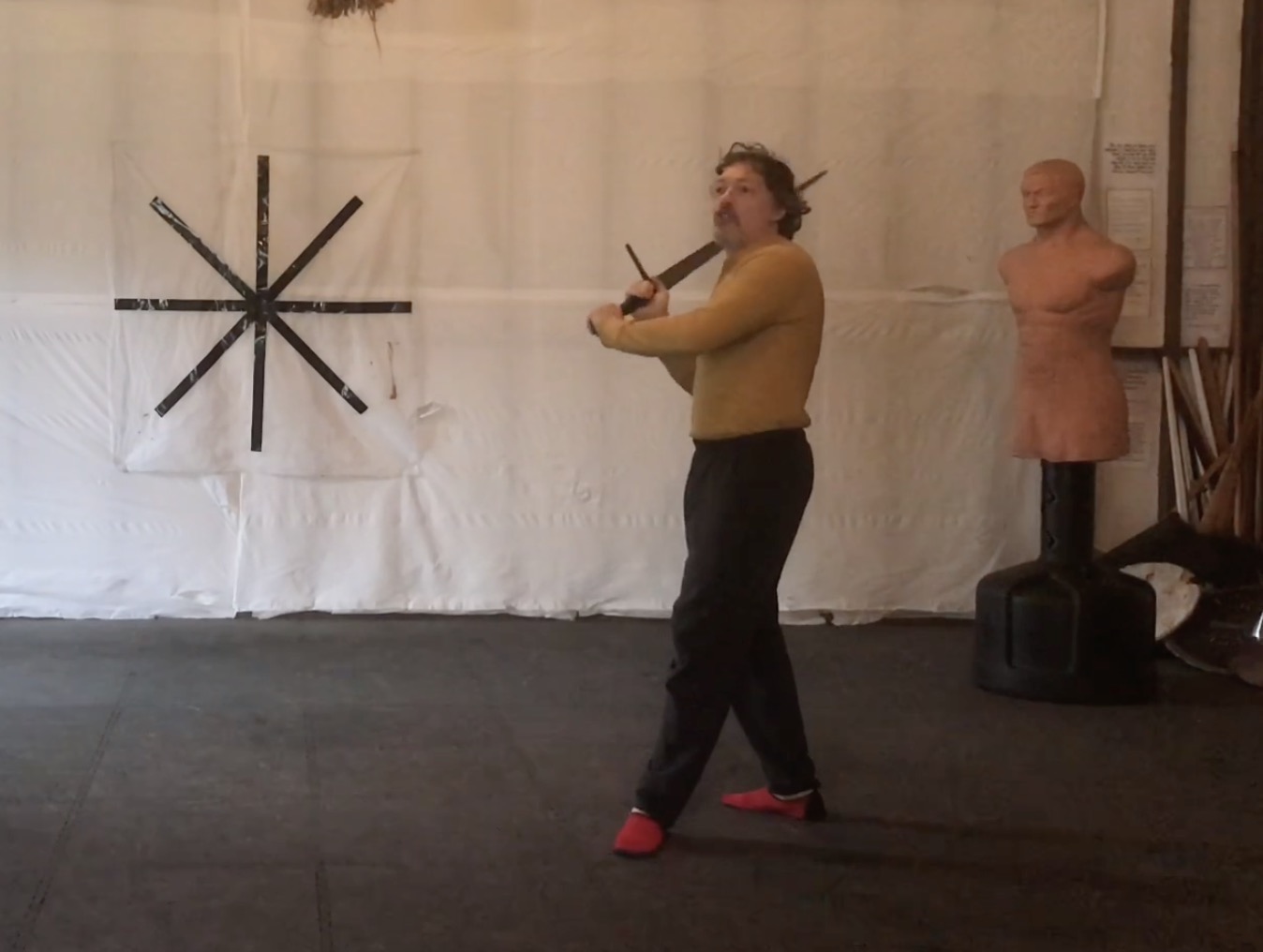
Striking
and Counterstriking
By
John Clements
Occasionally, I receive very basic questions from novices asking about
how to perform basic strikes, and I'm also still seeing at times folks
who are struggling with how to perform the mastercuts with a longsword
or messer. This often happens with practitioners who must train solo or
who do not have anyone of experience to direct them in a two-person drill.
Addressing this very question and providing essential lessons on it makes
up a large portion of my basic introductory curriculum. Here's some advice
that I've gotten good results with:
Striking well is about efficiency of motion to produce coordination and
power (speed and force). Whether offensive or defensive, a blow must be
done with action that aims the impact while directing its resistance.
Its movement should also be difficult for an opponent to anticipate or
predict. (For safe practice, you also need good control, which, paradoxically,
is developed by hitting strongly at a pell, not by going softly against
empty air.)
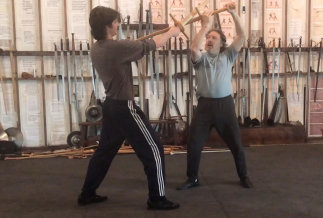 In
our craft, according to Liechtenauer's great teachings, all of this is
done with just five downward strikes/cuts: In
our craft, according to Liechtenauer's great teachings, all of this is
done with just five downward strikes/cuts:
- Diagonal
- Vertical
- Horizontal (delivered high)
- Short edge
- Crooked
Each of these five strikes is aimed along four intersecting target lines.
The first two are obvious. The third one must be understood that it's
made crosswise higher up. The fourth and fifth ones give people the most
trouble, but just understand this simple rule: One strikes along two angles
but with one edge. The other strikes along one angle but with two edges.
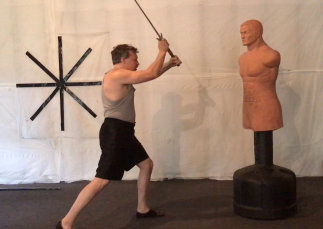 Ultimately,
every strike begins and ends in a stance or guard, and that strike is
itself also a parry. Any strike is therefore the motion connecting two
stances. Thus, between any two blows there is a guard and between two
guards a blow. This is why the first thing you learn is the stances, followed
by how to transition from one to the other. The stances allow you to cover
certain target areas while threatening to deliver certain attacks, but
the transitions themselves are, in effect, strikes. Ultimately,
every strike begins and ends in a stance or guard, and that strike is
itself also a parry. Any strike is therefore the motion connecting two
stances. Thus, between any two blows there is a guard and between two
guards a blow. This is why the first thing you learn is the stances, followed
by how to transition from one to the other. The stances allow you to cover
certain target areas while threatening to deliver certain attacks, but
the transitions themselves are, in effect, strikes.
Most importantly remember this: Just practicing these master strikes
as if they are attacks that occur in a vacuum is not enough. These strikes
are also parries. They simultaneously offend and defend in one motion.
In this Art, offense is defense. You'll use these as counterattacks that
are defenses-either in the middle of an opponent's attack or just as they
attempt to defend with their own counterstrike. You might strike first
in anticipation that they will attempt to counter you, so that you then
counter them. Or you may strike with the intention of hitting and instantly
countering off of the resistance they give you by trying to cover. Either
way, you are striking at them with the intention of hitting decisively
with your first or second blow.
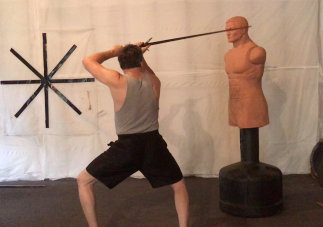 Each
"mastercut" has a specific posture, or strike from that posture, which
it ideally "breaks" or displaces. This occurs during the instance of the
opponent's own strike just as you come against their weapon, intercepting
and disrupting their action, playing off the clashing cross of weapons
that occurs. Each
"mastercut" has a specific posture, or strike from that posture, which
it ideally "breaks" or displaces. This occurs during the instance of the
opponent's own strike just as you come against their weapon, intercepting
and disrupting their action, playing off the clashing cross of weapons
that occurs.
But it's not a matter of detecting what blow an opponent is suddenly
attempting and then making a quick decision as to what counter to use.
This is impossible to do in the chaotic split seconds of a fight. Rather,
you need only act to intercept and impede their action. You do this by
closing against the portion of their weapon closest to their grip, that
moving the least with the least force behind it. You thereby instantly
act off of their strike or their attempt to counterstrike your attack.
Doing any of this requires that your motion encounter their weapon by
clashing with the lower, stronger portion of yours against a weaker upper
portion of theirs. But, at the end of the motion your strong will end
down against their strong. This contact gives you the very leverage point
of resistance by which you can then wind around and strike them.
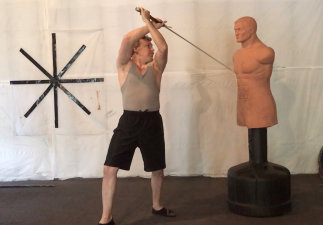 The
real secret is to simply be able to perform all this in a single tempo
and not as separate actions. It takes practice. You have to coordinate
your step with your hand motions so that your whole body works together.
You have to become proficient in it by improving your muscle tone as well
as your coordination. You also have to have good body mechanics, starting
with a proper stance, good gripping, and correct footwork. However, the
hardest part to acquire is the necessity of learning how for each blow
to adroitly turn your hands as needed so that you are using the back edge
or the front edge of your weapon. The
real secret is to simply be able to perform all this in a single tempo
and not as separate actions. It takes practice. You have to coordinate
your step with your hand motions so that your whole body works together.
You have to become proficient in it by improving your muscle tone as well
as your coordination. You also have to have good body mechanics, starting
with a proper stance, good gripping, and correct footwork. However, the
hardest part to acquire is the necessity of learning how for each blow
to adroitly turn your hands as needed so that you are using the back edge
or the front edge of your weapon.
It goes without saying that you must also sharpen your perception of
distance and timing so that you do not act too soon, too late, too closely,
or too distantly. On top of this, at the instant that your weapons clash
you must "feel" the pressure and gauge the resistance as to
whether it is stronger or weaker, for this will in an instant dictate
which cut you can best employ. Learning to be able to do this from the
"crown" position where you can rapidly turn your weapon to strike
left or right, high or low, is critical.
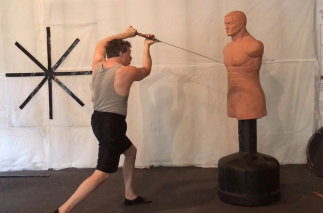 Lastly,
note that even though we refer to hitting with front and back "edges,"
you could also do these motions with a simple staff or a stick or even
an axe. It's only a matter of turning the hands to wind the point or butt
around. Whatever weapon you choose to work with, weather single or double
handed, you will soon find how its particular center of gravity, center
of rotation, and center of percussion permits these actions. Lastly,
note that even though we refer to hitting with front and back "edges,"
you could also do these motions with a simple staff or a stick or even
an axe. It's only a matter of turning the hands to wind the point or butt
around. Whatever weapon you choose to work with, weather single or double
handed, you will soon find how its particular center of gravity, center
of rotation, and center of percussion permits these actions.
Striking and counter-striking in this way is absolutely fundamental to
Medieval and Renaissance combat Arts. No matter what cut you are throwing,
no matter what blow, hit, slash, or slice, with either the forward or
back edge and even the flat, they are all merely one of these five. They
all strike to the "four quarters"-up or down, left or right,
back and forth- to make up a total of 16 possible blows. It's somewhat
counterintuitive at first, and certainly contrary to the crude "common"
method of parrying (and to later theories of fencing, as well), but I
assure you it quickly becomes instinctive. And it's powerfully effective.
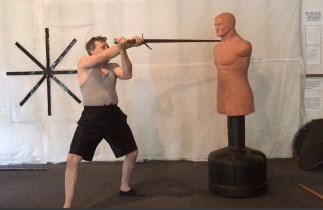 Obviously,
all of this requires a certain audacity. It requires you lose any mindset
that you must "stay away" and avoid an opponent's weapon instead of closing
in against it to stifle it and bind on it. It requires that you don't
defend by just putting your weapon out to let it be hit on. Instead, it
demands you strike, not at their opposing weapon, but directly at the
other person, and do so regardless of their weapon coming at you. Gaining
the confidence in your ability to control your weapon to not injure your
partner in classroom practice, but to also make firm placement of blows
in free play, is a big part of learning how to strike well. Similarly,
in learning to counter-strike, overcoming the instinct to flinch or block
or run away is difficult for some practitioners. But in time all the elements
fit together logically. Obviously,
all of this requires a certain audacity. It requires you lose any mindset
that you must "stay away" and avoid an opponent's weapon instead of closing
in against it to stifle it and bind on it. It requires that you don't
defend by just putting your weapon out to let it be hit on. Instead, it
demands you strike, not at their opposing weapon, but directly at the
other person, and do so regardless of their weapon coming at you. Gaining
the confidence in your ability to control your weapon to not injure your
partner in classroom practice, but to also make firm placement of blows
in free play, is a big part of learning how to strike well. Similarly,
in learning to counter-strike, overcoming the instinct to flinch or block
or run away is difficult for some practitioners. But in time all the elements
fit together logically.
As Master Joachim Meyer once expressed about learning the strikes, "the
cuts begin to arrange themselves according to everyone's character, nature,
strength, and ability, since the weak must seek a different advantage
in the cuts than the strong, and vice versa." The meaning being that,
as you learn you should develop your own way of optimally doing things.
But, Meyer also stated that fighting actions "are not so set in stone
that they cannot be changed in practice-they are merely examples from
which everyone may seek, derive, and learn devices according to his opportunity,
and may arrange and change them as suits him. For as we are not all of
a single nature, so we also cannot all have a single style in combat:
yet all must nonetheless arise and be derived from a single basis."
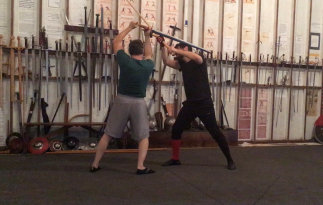 Wow.
What a profound lesson that is for any martial artist. And yet how few
seem to take it to heart. The problem is, when you have disagreements
about what exactly that "single basis" is, and how to practice it, let
alone how to implement it, you start to lose common ground. But, the nature
of the strikes remains and there is no denying Liechtenauer's formation
of them. There are objectively only so many angles by which to hit in
so many ways, and they must be learned. Wow.
What a profound lesson that is for any martial artist. And yet how few
seem to take it to heart. The problem is, when you have disagreements
about what exactly that "single basis" is, and how to practice it, let
alone how to implement it, you start to lose common ground. But, the nature
of the strikes remains and there is no denying Liechtenauer's formation
of them. There are objectively only so many angles by which to hit in
so many ways, and they must be learned.
10-2018
|

